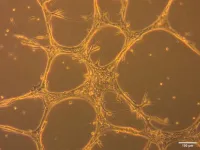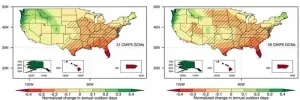(Press-News.org) UNIVERSITY PARK, Pa. — Blood vessels engineered from stem cells could help solve several research and clinical problems, from potentially providing a more comprehensive platform to screen if drug candidates can cross from the blood stream into the brain to developing lab-grown vascular tissue to support heart transplants, according to Penn State researchers. Led by Xiaojun “Lance” Lian, associate professor of biomedical engineering and of biology, the team discovered the specific molecular signals that can efficiently mature nascent stem cells into the endothelial cells that comprise the vessels and regulate exchanges to and from the blood stream.
They published their findings today (March 21) in Stem Cell Reports. The team already holds a patent on foundational method developed 10 years ago and has filed a provisional application for the expanded technology described in this paper.
The researchers found they could achieve up to a 92% endothelial cell conversion rate by applying two proteins — SOX17 and FGF2 — to human pluripotent stem cells. This type of stem cell, which the researchers derived from a federally approved stem cell line, can differentiate into almost any other cell type if provided the right proteins or other biochemical signals. SOX17 and FGF2 engage three markers in stem cells, triggering a growth cascade that not only converts them to endothelial cells but also enables them to form tubular-like vessels in a dish.
The more efficient differentiation and lab-grown vessels could allow researchers to grow an artificial blood brain barrier to test neurological drugs under development, according to Lian. Other eventual clinical uses may include reestablishing vascular structures after heart damage.
“Drugs designed to treat brain diseases need to pass through the blood brain barrier to be effective,” Lian said. The blood brain barrier is a membrane packed with vessels and regulates what can pass from the blood into the brain. “Our cells can form a tight layer in a dish, onto which we could add various chemicals and see how they pass through.”
Next, Lian said, the team will collaborate with industry partners to advance the artificial blood brain barrier and begin testing various drugs. Getting to this point, however, required a decade of investigating the molecular mechanism underpinning how stem cells convert to endothelial cells.
“In 2014, we published a protocol using a small molecule that could help the cells differentiate about 20% of the time, but we’ve now found that just one gene, SOX17, is sufficient for differentiating the about 80% of cells into endothelial cells,” said Lian, associate professor of biomedical engineering and of biology at Penn State. “That was completely unknown.”
In their prior stem cell differentiation process, the low efficiency resulted in heterogenous cell populations, making them difficult to sort and to obtain enough for other research or clinical applications. Lian explained that the researchers knew some of the cells were endothelial cells, but they couldn’t predict the other cell types.
To make more homogenous populations, the researchers examined the proteins at play during the process. They first noticed that cells expressed SOX17 during differentiation, so they removed the cells’ ability to express the protein and analyzed how its absence changed function.
“Before knocking down SOX17 expression, about 20% of stem cells would become endothelial cells,” Lian said “After, differentiation dropped to about 5% at best. We found that SOX17 is required for this process. It was a lucky and surprising finding.”
With the addition of SOX17, 80% of stem cells could differentiate. But the researchers wanted to do better, Lian said. The stem cells produce three markers, but SOX17 only triggers two of them to begin the differentiation process. The third marker, called CD31, doesn’t work when only exposed to SOX17.
“That was a problem for us. We spent two to three years figuring out why,” Lian said, explaining that another protein, called FGF2 could induce the marker without affecting SOX17’s influence on the other two markers. The combination results in up to 92% of the stem cells differentiating into endothelial cells — a more than 350% increase in efficiency from the researchers’ original approach. “Sometimes science is very difficult, but we do not give up.”
With all three markers activated, the differentiated cells can form tubular-like vessels in a dish. They can also uptake proteins, like blood vessels in the body. The researchers tested this ability by inducing inflammation to see if the endothelial cells could detect the protein signal involved — they could.
“Our cells are indeed functional,” Lian said. “With SOX17 and FGF2, we can determine the fate of these stem cells to be precisely what we need.”
Lian is also affiliated with the Materials Research Institute and the Huck Institutes of the Life Sciences at Penn State. Other collaborators on the study include Michael W. Ream, who is a graduate student in the Lian lab in the Department of Biomedical Engineering; Lauren N. Randolph, who earned her doctorate degree in biomedical engineering at Penn State and is now with the San Raffaele Telethon Institute for Gene Therapy in Italy; Yuqian Jian, who also earned her doctoral degree in biomedical engineering at Penn State and is now with the Departments of Pediatrics and of Genetics at Stanford University; and Yun Chang and Xiaoping Bao, both with Purdue University’s Davidson School of Chemical Engineering.
The U.S. National Science Foundation and the National Institutes of Health funded this research.
END
Two keys needed to crack three locks for better engineered blood vessels
Penn State researchers discovered two proteins that differentiate stem cells into the components of blood vessels, finding has implications for drug testing and other clinical applications
2024-03-21
ELSE PRESS RELEASES FROM THIS DATE:
UTEP faculty launch research lab to support human performance
2024-03-21
EL PASO, Texas (Mar. 21, 2024) - Professors at The University of Texas at El Paso have launched a new industrial engineering lab focused on supporting human performance and behavior in various application areas. Projects include supportive exoskeletons for high-strain occupations and virtual reality that simulates high-stress environments.
The facility, known as the Physical, Information and Cognitive Human Factors Engineering (PIC-HFE) Research Lab, was established with the help of a $350,000 STAR grant from the State of Texas.
The lab is led by Priyadarshini Pennathur, Ph.D., and Arunkumar ...
Improving & maintaining heart health after pregnancy may reduce the risk of future CVD
2024-03-21
Research Highlights:
An analysis of health records for almost 110,000 women in the U.K. found that women with poor cardiovascular health after pregnancy or who experienced adverse pregnancy outcomes, including high blood pressure, gestational diabetes and/or pre-term birth, had a significantly higher long-term risk of developing cardiovascular disease.
Among women with adverse pregnancy outcomes, those who maintained better cardiovascular health after pregnancy had cardiovascular disease risk similar to women who had no history of pregnancy complications.
Embargoed until 1:30 p.m. CT/2:30 ...
New generation estrogen receptor-targeted agents in breast cancer
2024-03-21
https://www.scienceopen.com/hosted-document?doi=10.15212/AMM-2024-0006
Announcing a new publication for Acta Materia Medica journal. Endocrine therapy that blocks estrogen receptor signaling has been effective for decades as a primary treatment choice for breast cancer patients expressing the estrogen receptor. However, the issue of drug resistance poses a significant clinical challenge. It is therefore critically important to create new therapeutic agents that can suppress ERα activity, particularly in cases of ESR1 mutations. This review article highlights recent efforts in drug development of next ...
A new way to quantify climate change impacts: “Outdoor days”
2024-03-21
For most people, reading about the difference between a global average temperature rise of 1.5 C versus 2 C doesn’t conjure up a clear image of how their daily lives will actually be affected. So, researchers at MIT have come up with a different way of measuring and describing what global climate change patterns, in specific regions around the world, will mean for people’s daily activities and their quality of life.
The new measure, called “outdoor days,” describes the number of days per year that outdoor temperatures are neither too ...
Scientists find core regulatory circuit controlling identity of aggressive leukemia
2024-03-21
A collaboration between scientists from St. Jude Children’s Research Hospital and Dana-Farber Cancer Institute uncovered four proteins that govern the identity of anaplastic large cell lymphoma (ALCL), an aggressive form of cancer. These proteins comprise a core regulatory circuit (CRC) that surprisingly incorporates a dysregulated signaling protein. Establishing the CRC for this lymphoma gives researchers insight into potential vulnerabilities that may be future therapeutic targets. The findings were published today in Cell Reports Medicine.
“Mutations in signaling pathways have long been known to drive oncogenic transformation ...
Organic fields increase pesticide use in nearby conventional fields, but reduce it in organic neighbors
2024-03-21
Expanding organic cropland can lead to increased pesticide use in surrounding conventional fields while reducing pesticide use on nearby organic fields, according to a study based in a leading U.S. crop-producing region. The findings provide insight into overlooked environmental impacts of organic agriculture and suggest that clustering organic fields could reduce pesticide use at the landscape scale. Organic agricultural practices are designed to have less negative local environmental impacts than other forms of intensive agriculture. However, the ...
Revealed: A gene underlying visual mating behaviors in Heliconius butterflies
2024-03-21
A particular gene plays a critical role in visual preference for mate choice between closely related Heliconius butterflies, according to a new study. The findings provide insight into how visually guided behaviors can be encoded within the genome. Many species use color and other visual cues to attract and recognize suitable mates. As such, visual preferences are important drivers of mate choice and sexual selection. However, while the genetics and evolution of the traits that serve as these cues – such as butterfly wing color – are ...
Novel approach yields better single-copy artificial human chromosomes
2024-03-21
Constructing human artificial chromosomes (HACs) in budding yeast overcomes the long-standing problem of uncontrolled multimerization – the rampant joining of similar molecules – and results in HACs that are large, stable, and structurally well-defined, researchers report. The findings may help advance chromosome engineering for precise genome editing in mammals and many other organisms. Artificial chromosomes can carry large numbers of engineered genes. Their use in bacteria and yeast as vehicles for writing and rewriting genomes has hinted at their potential to provide an alternative approach to editing genetic material in human cell lines. Although the first HACs were ...
A path forward from the “equity versus excellence” conflict that has impeded mathematics education in U.S.
2024-03-21
In a Policy Forum, Alan Schoenfeld and Phil Daro argue that the “equity versus excellence” controversy over how mathematics is taught has long disrupted education in the United States, particularly for underrepresented ethnic and socioeconomic groups. According to Schoenfeld and Daro, K-12 mathematics education in the U.S. is structured in ways that are problematic and do not reflect international trends. For more than 50 years, the typical yet rigid sequence of hierarchical mathematics courses – algebra 1 to geometry to algebra II to precalculus to calculus – has disenfranchised ...
How butterflies choose mates: gene controls preferences
2024-03-21
Tropical Heliconius butterflies are well known for the bright colour patterns on their wings. These striking colour patterns not only scare off predators – the butterflies are poisonous and are distasteful to birds – but are also important signals during mate selection. A team led by evolutionary biologist Richard Merrill from LMU Munich, in cooperation with researchers from the Universidad del Rosario in Bogotá (Colombia) and the Smithsonian Tropical Research Institute (Panama), has now exploited the diversity of warning patterns of various Heliconius species to investigate the genetic foundations of these preferences. ...
LAST 30 PRESS RELEASES:
Injectable breast ‘implant’ offers alternative to traditional surgeries
Neuroscientists devise formulas to measure multilingualism
New prostate cancer trial seeks to reduce toxicity without sacrificing efficacy
Geometry shapes life
A CRISPR screen reveals many previously unrecognized genes required for brain development and a new neurodevelopmental disorder
Hot flush treatment has anti-breast cancer activity, study finds
Securing AI systems against growing cybersecurity threats
Longest observation of an active solar region
Why nail-biting, procrastination and other self-sabotaging behaviors are rooted in survival instincts
Regional variations in mechanical properties of porcine leptomeninges
Artificial empathy in therapy and healthcare: advancements in interpersonal interaction technologies
Why some brains switch gears more efficiently than others
UVA’s Jundong Li wins ICDM’S 2025 Tao Li Award for data mining, machine learning
UVA’s low-power, high-performance computer power player Mircea Stan earns National Academy of Inventors fellowship
Not playing by the rules: USU researcher explores filamentous algae dynamics in rivers
Do our body clocks influence our risk of dementia?
Anthropologists offer new evidence of bipedalism in long-debated fossil discovery
Safer receipt paper from wood
Dosage-sensitive genes suggest no whole-genome duplications in ancestral angiosperm
First ancient human herpesvirus genomes document their deep history with humans
Why Some Bacteria Survive Antibiotics and How to Stop Them - New study reveals that bacteria can survive antibiotic treatment through two fundamentally different “shutdown modes”
UCLA study links scar healing to dangerous placenta condition
CHANGE-seq-BE finds off-target changes in the genome from base editors
The Journal of Nuclear Medicine Ahead-of-Print Tip Sheet: January 2, 2026
Delayed or absent first dose of measles, mumps, and rubella vaccination
Trends in US preterm birth rates by household income and race and ethnicity
Study identifies potential biomarker linked to progression and brain inflammation in multiple sclerosis
Many mothers in Norway do not show up for postnatal check-ups
Researchers want to find out why quick clay is so unstable
Superradiant spins show teamwork at the quantum scale
[Press-News.org] Two keys needed to crack three locks for better engineered blood vesselsPenn State researchers discovered two proteins that differentiate stem cells into the components of blood vessels, finding has implications for drug testing and other clinical applications






